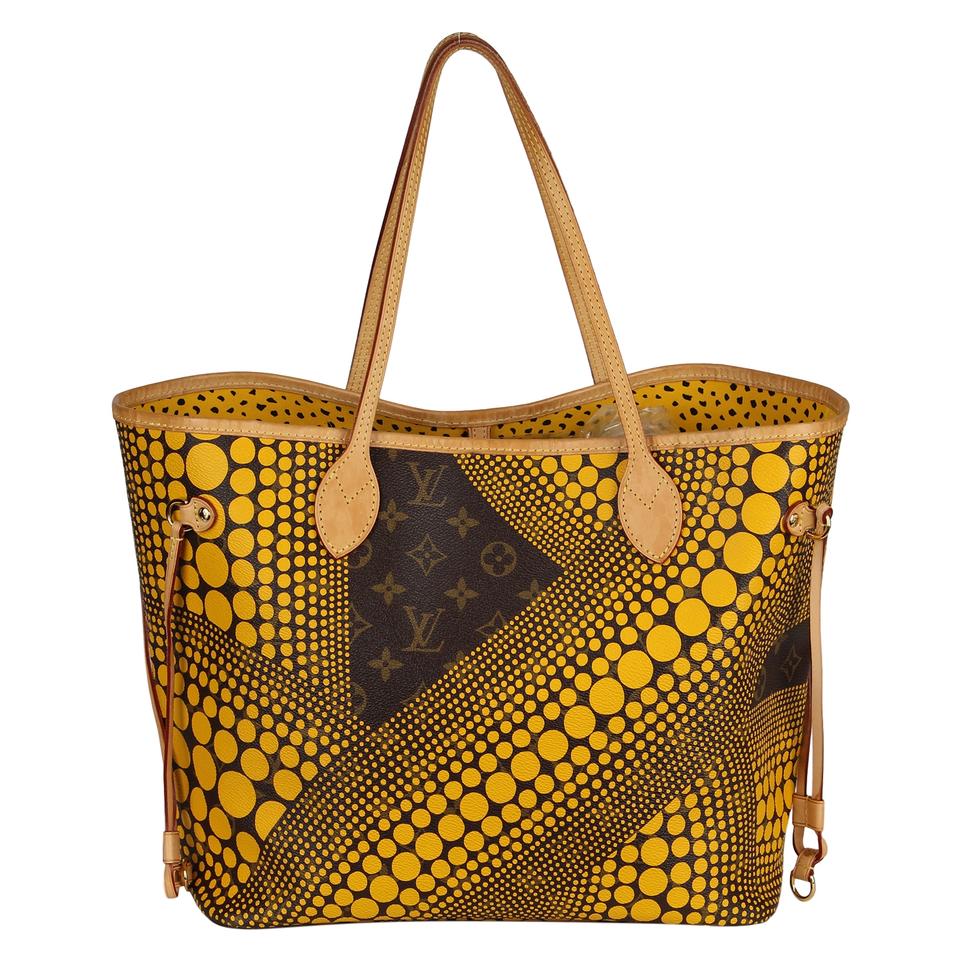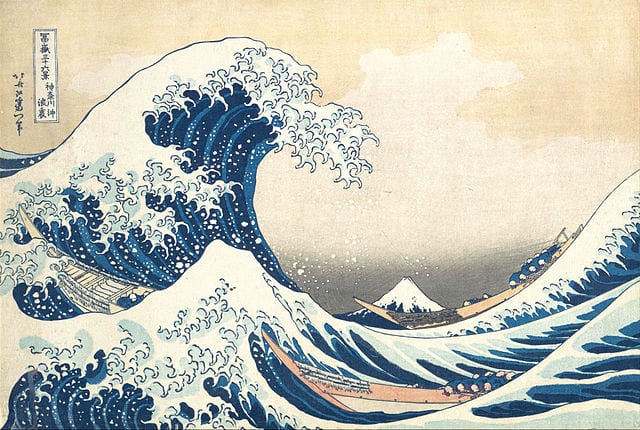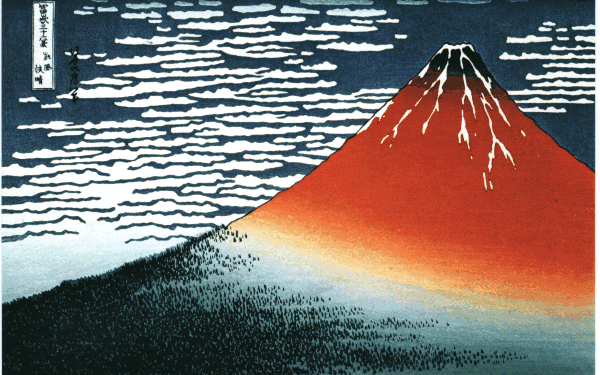Hokusai, The Great Wave Rebel: How the Japanese Printmaker Shaped the Impressionist Movement in Europe
It’s one of the most iconic woodblock prints in the world, but many people still don’t know The Great Wave’s creator Katsushika Hokusai. Some would argue that his Great Wave, also known as Under the Wave off Kanagava, is the most famous of all Japanese art.
The print, circa 1830-1832, features a giant, frothing wave with views of Mount Fuji in the far distance.
While The Great Wave art may be Hokusai’s most famous work, he didn’t produce the piece until 60 years after he first started creating art. Throughout his fruitful career, Hokusai created more than 30,000 works of art. His wave print was part of a 36-piece series known as Thirty-Six Views of Mount Fuji.
It was this iconic impressionist painting that would shape the Impressionist movement in Europe.
The Life of Katsushika Hokusai
Born in 1760 in Edo, Japan (modern day Tokyo), Hokusai went by over 30 different names throughout his career. Changing names was common practice among Japanese artists, but Hokusai took things a step further by giving himself a new pseudonym every few years. His adopted names included Sori, Shunro, Taito, Kako, Manji, Gakojin and Katsushika Hokusai. He would keep his Hokusai name for half a century. Hokusai changed homes almost as often as he changed names. By the end of his life, he had relocated 93 times. It was rumoured that he hated to clean, so he would allow his homes to build up with dirt until they became unbearable and he was forced to leave. Growing up, Hokusai lived with his uncle, a mirror polisher for the commander-in-chief of feudal Japan. The prestigious position gave Hokusai direct contact with the upper class and the opportunity for an excellent education. Hokusai was being groomed to replace his uncle after he died. But in 19th century Japan, an education meant learning how to read, write, and, consequently, draw. Hokusai’s artistic talent was evident early on, when he was just 6 years old. His talents led him down a different path than the one his uncle intended. As a teenager, Hokusai became a woodblock carver’s apprentice. During this time, he learned the skills he would later use to create his most famous works. At the young age of 19, Hokusai joined the studio of ukiyo-e artist Katsukawa Shunsho. The apprenticeship set him on the path of his 70-year career in art. Early in his career, Hokusai designed dioramas, which were made as toys for children. He created board games, which featured landscape designs. He also created a series of images for aspiring artists to study and copy. These works were compiled into a book known as Hokusai Manga, one of the earliest forms of manga art. It is said that Hokusai would paint from sunrise to sunset, but despite his productivity, he faced his fair share of difficulties throughout his life. Both of his wives and his two children died. At the age of 50, he was struck by lightning. In his 60s, he suffered a stroke that would force him to relearn his art. Hokusai was also forced to pay his grandson’s gambling debts, which would place financial strain on the artist for the rest of his life. But it was these hardships that would influence Hokusai to create his most famous collection of work: Thirty-Six Views of Mount Fuji. Hokusai’s Great Wave piece featured hues of Prussian blue, a pigment previously only used by the richest of artists because of its rarity. While Hokusai has clearly influenced other renowned artists in Europe, he himself was influenced by European styles. Hokusai studied European works and was especially influenced by the linear perspective that was used by Dutch artists. Despite its popularity, the series was not considered great art by Japanese art historians of the time. They viewed woodblock prints as a form of commercial printing – not fine art. But today, original prints of The Great Wave are beloved by museums around the world, including The British Museum of London, The Metropolitan Museum of Art in New York City, the Art Institute of Chicago, Melbourne’s National Gallery of Victoria and LACMA of Los Angeles.
Hokusai and Ukiyo-e
The work of Katsushika Hokusai falls under the genre of Japanese art known as ukiyo-e, which flourished from the 17th to the 19th centuries. Artists of the genre created woodblock prints and paintings of kabuki actors, females, sumo wrestlers, landscapes, travel scenes, fauna and flora, historic scenes, scenes from folk tales, and even erotica. Hokusai’s work focused primarily on landscapes, nature and the everyday lives of the Japanese people.
How Katsushika Hokusai Shaped the Impressionist Movement in Europe
Throughout Hokusai’s career, government policies in Japan prevented any import or export of goods. It also prevented the free movement of its people as well as foreigners who wanted to visit or exit the country. Once Japan finally opened its borders in the 1850s, Europe fell in love with Japanese art – particularly Hokusai’s work. In fact, his work was collected by some of the most beloved western artists, including Claude Monet, who collected 23 of the artist’s prints. Hokusai’s influence is also evident in Édouard Manet, particularly his focus on women and his depictions of everyday living. His style and subjects were influenced by Hokusai’s work. Impressionist artists Camille Pissarro and Alfred Sisley were also influenced by Hokusai’s work and Japanese art in general. Hokusai’s landscapes weren’t the only inspiration to western artists. The Japanese artist was also an influence on Edgar Degas, particularly with his thousands of sketches of the human form. Earlier in his career, Hokusai created thousands of sketches of sumo wrestlers, fish, geisha and everyday people in what is considered one of the earliest form of manga. The portraits created by Degas display many of the same characteristics of Japanese portraiture, but the influence of Hokusai is particularly evident in his bathers. Some believe that European artists were quick to embrace his prints because of his use of Western-style vanishing point perspective. In France, Hokusai’s work elevated printmaking to a respectable medium for artists. When writing to fellow artist Berthe Morisot, Mary Cassatt spoke of a Japanese prints exhibition. “You who want to make colour prints, you couldn’t imagine anything more beautiful... You must see the Japanese – come as soon as you can,” she wrote. Cassatt’s printmaking coincided with the arrival of Japanese art in France. Painter Henri de Toulouse-Lautrec passionately embraced Japanese art and was influenced by Hokusai. He began his career as a painter, but would move almost exclusively to posters and prints.
Hokusai’s Influence on Japanese Art and Ukiyo-e
Hokusai’s work helped shape impressionism in Europe, but he also influenced other Japanese artists, particularly ukiyo-e artists. Utagawa Hiroshige was the last known master of ukiyo-e art and is considered Hokusai’s greatest rival in stature. Hiroshige is best known for his travel series The Fifty-three Stations of the Tokaido. In modern Japanese art, we can see Hokusai’s influence in artists like Yayoi Kusama, known for her Infinity Mirror Rooms, use of polka dots and her collaboration with Louis Vuitton.
Hokusai’s influence is also found in Takashi Murakami’s work, particularly his famous 727 from 1996. The contemporary triptych features the artist’s avatar, known as Mr. DOB. Mr. DOB sits atop a cresting wave, a clear reference to Hokusai’s The Great Wave.









